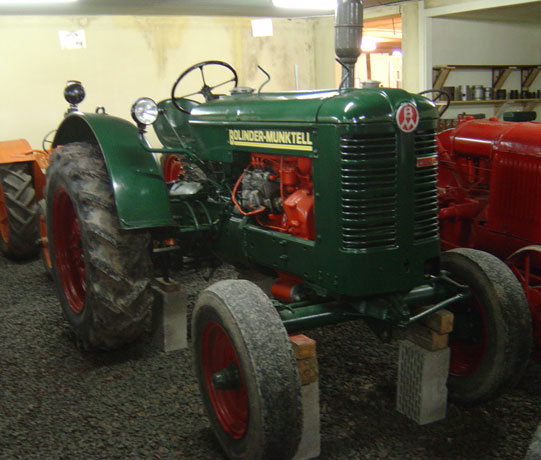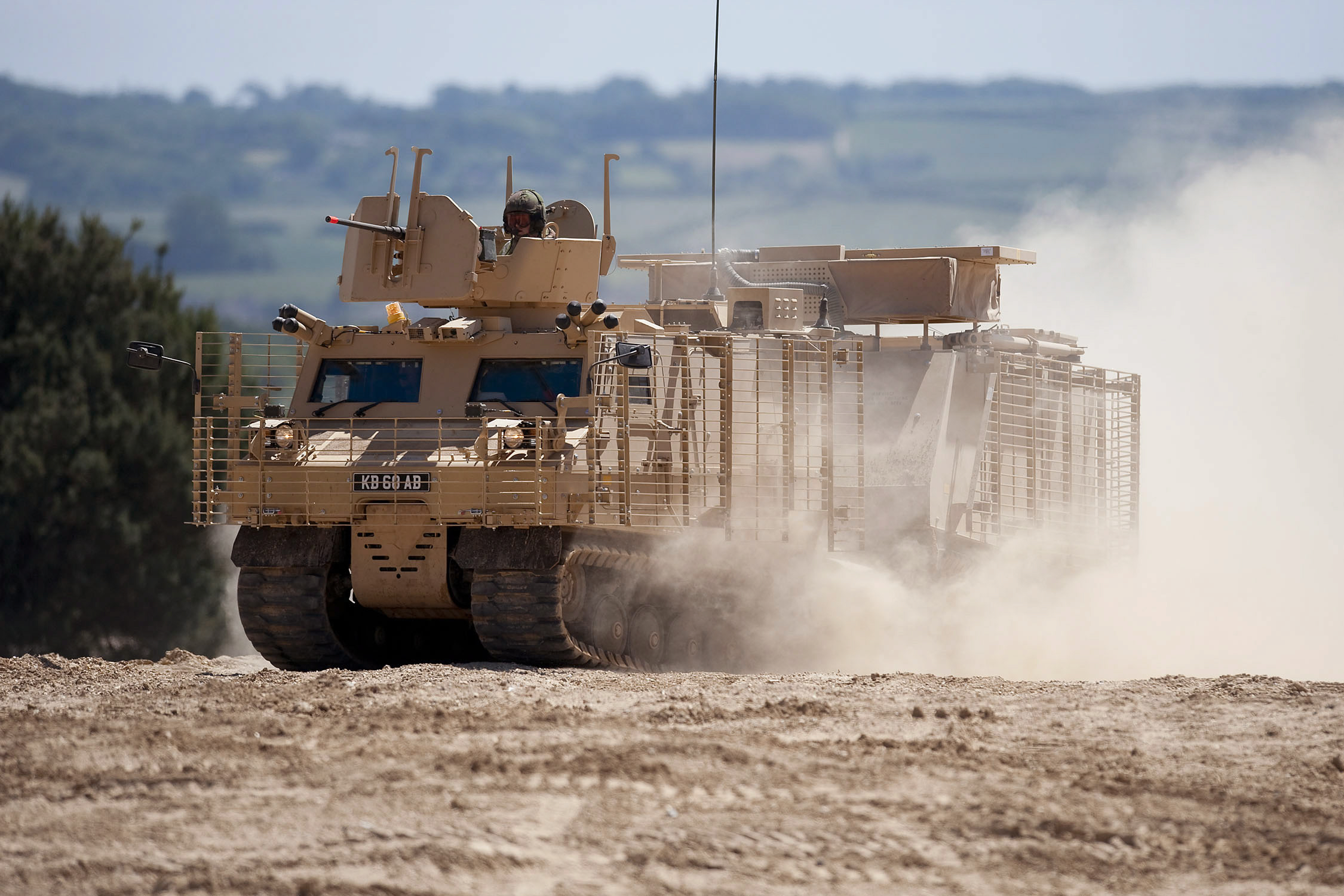|
Sisu Nasu
The Nasu (acronym for Nauha-Sisu, en, Track Sisu; also meaning " Piglet" in colloquial Finnish) is a tracked articulated, all-terrain transport vehicle developed by Sisu Auto for the Finnish Army. It consists of two units, with all four tracks powered. It can carry up to 17 people, although the trailer unit can be adapted for different applications (see Variants section). There are two main versions, the NA-140 BT and the NA-110. The Nasu was tested in 1985, and the next year 11 pre-production units were ordered. Since then, more than five hundred have been manufactured to equip the armies of India, Turkey and Finland. Although it looks externally like the Bandvagn 206, which also is in Finnish Army use, it is an entirely new design, and almost 1 meter longer and heavier. It has better payload-carrying capability than the Bv 206. The Nasu is designed to carry troops and equipment through snow and bog-lands in northern Finland. For this, it is equipped with four wide (62 c ... [...More Info...] [...Related Items...] OR: [Wikipedia] [Google] [Baidu] |
NSV (machine Gun)
The NSV (Russian НСВ Никитина-Соколова-Волкова), also known as the «Utyos» (Project: ''Lonely Cliff''), is a 12.7mm caliber heavy machine gun of Soviet origin, named after the designers, G. I. Nikitin (Г. И. Никитин), Y. S. Sokolov (Ю. М. Соколов) and V. I. Volkov (В. И. Волков). It was designed to replace the DShK machine gun and was adopted by the Soviet Army in 1971. It is no longer being produced in Russia; the manufacturing license for the NSV ended up in Kazakhstan after the break-up of the Soviet Union. The NSV has been manufactured in Bulgaria, India, Poland and Yugoslavia under license. The NSV weighs , has a rate of fire of 700–800 rounds per minute, and an effective range from to against airborne and ground targets, respectively. A loaded ammunition belt with 50 rounds weighs . The NSVT version is used on the T-72, T-64 and T-80 tanks. The new Kord machine gun has replaced worn-out NSVs in some countries. Hi ... [...More Info...] [...Related Items...] OR: [Wikipedia] [Google] [Baidu] |
Aboa (research Station)
Aboa (from the Latin name of Turku) is a seasonal Finnish research station in Antarctica, located in Queen Maud Land, about from the coast, on a nunatak called Basen in the Vestfjella Mountains. Facilities and purpose Opened in 1988, the station was designed and built by VTT Technical Research Centre of Finland, and funded by the Finnish Ministry of Trade and Industry (now part of the Finnish Ministry of Employment and the Economy)."Aboa research station" Finnish Antarctic Research Program (FINNARP) The station is used in the Antarctic summer only. Currently the station has living and work space for expeditions of 15 people, and allows temporary living space for up to 17 people. The |
Sisu Vehicles
SiSU (SiSU information structuring universe or Structured information, serialized units), is a Unix command line-oriented framework for document structuring, publishing and search. Usage Using markup applied to a document, or a collection of documents, SiSU can produce plain text, HTML, XHTML, EPUB, XML, OpenDocument, LaTeX or PDF files, and populate an SQL database. Document structuring SiSU offers its user a way to structure plain text and to add graphics, hyperlinks, endnotes, footnotes etc. with simple text editing programs such as Notepad (Windows), TextEdit (Mac) or Gedit (Linux). The lightweight markup language is mnemonic and human readable. To process the marked up document(s) with SiSU, the user issues a command via the command-line of the computer terminal. The output can be generated in multiple formats (html, pdf, epub, and others) with one single command. Publishing and self-publishing A document, or a collection of documents, which has been processed by ... [...More Info...] [...Related Items...] OR: [Wikipedia] [Google] [Baidu] |
Bandvagn 202
Bandvagn 202 (Bv 202) is a tracked articulated, all-terrain vehicle developed by Bolinder-Munktell, a subsidiary of Volvo, for the Swedish Army. Description The vehicle is formed by two rubber Kegresse track units with a multi-directional pivot in between. The front unit contains the engine and gearbox through which power is delivered to the front and, via a propshaft in the pivot mechanism, the rear tracks. A hydraulic ram on the pivot "bends" the vehicle in the middle to steer it—there is no braking of track units for steering as on conventional tracklaying vehicles. The controls are a conventional steering wheel on the left hand front of the vehicle. It can reach a speed of 35 km/h on land and 7 km/h (4 kn) on water. The Bv 202 carries a driver and a commander in the front unit and 8–10 troops in the trailer unit. It can be adapted for other applications. Production started in Arvika in 1964 and ended in 1981. The Bv 202 has since been succeeded by the Hägglun ... [...More Info...] [...Related Items...] OR: [Wikipedia] [Google] [Baidu] |
Bolinder-Munktell
AB Bolinder-Munktell (BM) was a tractor and machines manufacturer founded in Eskilstuna, Sweden in 1932 through the merger of the mechanical companies Bolinder and Munktell. Bolinder are also well known as manufacturers of 'Semi-Diesel' or 'Hot bulb' engines. In 1950 BM was bought by AB Volvo. In 1973 the company changed its name to Volvo BM AB and then in 1995 to Volvo Construction Equipment. The product range has changed with the times. Up to the beginning of the 20th century agricultural machines such as threshers were an important product. Products Marine engines Bolinder produced a wide range of marine engines, mostly of the semi-diesel hot bulb type. Some of those sizes proved to be ideal in narrow boats, and some Bolinder motors so used are still in use. When starting, the cylinder head has to be heated with a kerosene blowtorch to get the hot bulb heated, and to be able to start the combustion process. Tractors Tractor production commenced in 1913, with the type 3 ... [...More Info...] [...Related Items...] OR: [Wikipedia] [Google] [Baidu] |
Vityaz (ATV)
The Vityaz DT-30 is a multi-purpose Tracked articulated vehicle, articulated tracked carrier developed in the Soviet Union. It was designed to carry heavy loads in difficult terrain like swamps, sand and snow in extreme weather conditions. History By the early 1960s, the Soviet Union's increased need for a more advanced ATV was becoming obvious as the single-unit tracked snow and swamp-going vehicles in operation at that time could not carry payloads in excess of . To fill the need for such vehicles, a specialized design bureau was established with the task of developing articulated tracked vehicles. Also a military vehicle able to operate on USSR northern borders was deemed necessary. In February 1971 the first two ATVs, designated DT-LP and DT-L, were produced for the State trials. Three types operational today (DT-10P, DT-20P and DT-30 ATVs) entered service in 1980s. In 1982, the Ishimbai Transport Machine-Building Plant (''Ishimbaitransmash'') assimilated the series productio ... [...More Info...] [...Related Items...] OR: [Wikipedia] [Google] [Baidu] |
BvS 10
The BvS10 (''Bandvagn Skyddad'' 10) is a tracked articulated amphibious all-terrain armoured vehicle produced by BAE Systems Land Systems Hägglunds of Sweden. This vehicle, referred to as the All Terrain Vehicle (protected) - ATV(P) or ''Viking'' by the UK forces, was originally developed as a collaboration between industry - Hägglunds Vehicle AB - and the British Ministry of Defence (MoD) on behalf of the Royal Marines. The BvS10 is similar to, but distinct from, Hägglunds earlier Bandvagn 206 or Bv 206S. It is a much larger vehicle based upon the characteristic twin-cab, articulated frame-steering system typical of Hägglunds all-terrain vehicles. The main differences from the older Bv206s are a more powerful Cummins 5.9 litre diesel engine, improved ground clearance, and newly developed chassis, power train and steering units that give the vehicle considerably enhanced speed (up to 65 km/h from the previous 51.5 km/h on road) and comfort on road and in terrain, a ... [...More Info...] [...Related Items...] OR: [Wikipedia] [Google] [Baidu] |
Bronco All Terrain Tracked Carrier
The Bronco All Terrain Tracked Carrier (ATTC) is a twin chassis multi-purpose tracked articulated vehicle jointly developed by ST Kinetics and the Defence Science & Technology Agency (DSTA) for the Singapore Army. The variant which was in service as a UOR with the UK armed forces is known as the Warthog. Design Designed to traverse difficult terrain, the Bronco has a ground pressure of 60 kPa and is fitted with heavy-duty seamless rubber tracks and a running gear system for soft ground conditions and directional stability. Swimming operations require minimal preparation and it can achieve a swimming speed of 5 km/h. The Bronco's four-sprocket drive, fully articulated steering with optional differential lock provides for small turning radius manoeuvres and improved performance. The Bronco has a load carrying capacity of up to 5 tonnes and is capable of a top speed of on the road and at least on cross-country terrain. An advantage the standard Bronco has over othe ... [...More Info...] [...Related Items...] OR: [Wikipedia] [Google] [Baidu] |
ST Kinetics
ST Engineering Land Systems Ltd (STELS), doing business as ST Kinetics, is a strategic business area of ST Engineering and handles land systems and specialty vehicles. In 2000, ST Engineering acquired the Chartered Industries of Singapore (CIS) through ST Automotive, a subsidiary of ST Engineering, and the new company was named ST Kinetics. Given the initial charter of CIS to support the local defence requirements, the main defence customer of ST Kinetics remains as the Singapore Armed Forces (SAF). Besides manufacturing small arms and munitions, some of STELS' key military products include the SAR 21 assault rifle, the Bionix AFV, the Bronco All Terrain Tracked Carrier and the Terrex APC. These weapons and ammunition are often made to the United States or NATO specifications for export. The company holds a number of subsidiaries overseas, mainly in the United States, Canada and China. Recent acquisitions between 2004 and 2009 have seen new construction equipment, specialised ... [...More Info...] [...Related Items...] OR: [Wikipedia] [Google] [Baidu] |
BAE Systems AB
BAE Systems AB is a Swedish defence company and a subsidiary of BAE Systems Land & Armaments, whose ultimate parent is the British defence contractor BAE Systems. The company is a holding company for Land Systems Hägglunds AB and BAE Systems Bofors AB, and has no products of its own. Subsidiaries BAE Systems Hägglunds ''AB Hägglund & Söner'' was founded in 1899 by Johan Hägglund in Gullänget, Örnsköldsvik, Sweden. The company was divided in 1988, one part being ''Hägglunds Vehicle AB'', the military vehicles business. In October 1997 the British company Alvis plc acquired Hägglunds Vehicle AB to form Alvis Hägglunds AB. Alvis expanded its military vehicle business in 1998 with the purchase of GKN's armoured vehicle division in 1998 and Vickers Defence in 2002 to form Alvis Vickers. In September 2004 BAE Systems acquired Alvis Vickers and merged it with its RO Defence ordnance division to form BAE Systems Land Systems. Hägglunds was renamed Land Systems Hägglunds. In ... [...More Info...] [...Related Items...] OR: [Wikipedia] [Google] [Baidu] |







